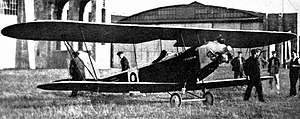| Sparrow | |
|---|---|

| |
| Sparrow I at the 1924 Two-Seater Light Aeroplane Competition at Lympne | |
| Role | Two-seat light sports aircraft |
| National origin | United Kingdom |
| Manufacturer | Supermarine Aviation Works |
| Designer | R.J. Mitchell |
| First flight | 11 September 1924 |
| Retired | 1930 |
| Number built | 1 |
The Supermarine Sparrow (later called the Sparrow I) was a British two-seat light biplane designed by R.J. Mitchell and built at Supermarine's works at Woolston, Southampton. It first flew on 11 September 1924. After being rebuilt in 1926 as a parasol monoplane, it was re-designated Sparrow II.
The Sparrow was Supermarine's earliest landplane. It was a wooden two-seat sesquiplane powered by a 35-horsepower (26 kW) Blackburne Thrush. It had foldable wings with different cross sections; to allow the aircraft to take-off and land over short distances, Mitchell gave the wings a high angle of attack. The Sparrow behaved erratically during tests. It was entered for the 1924 Two-Seater Light Aeroplane Competition but suffered engine failure during the competition. A substitute engine failed during the race, forcing the pilot to land at short notice, and the plane was eliminated.
Sparrow II was heavier and slower than its predecessor. It was entered for the 1926 competition at Lympne but, having made a forced landing near Beachy Head, was eliminated. Mitchell went on to use Sparrow II to test new aerofoil designs for the Air Ministry. It was subsequently sold to a flying club and was scrapped in 1933.